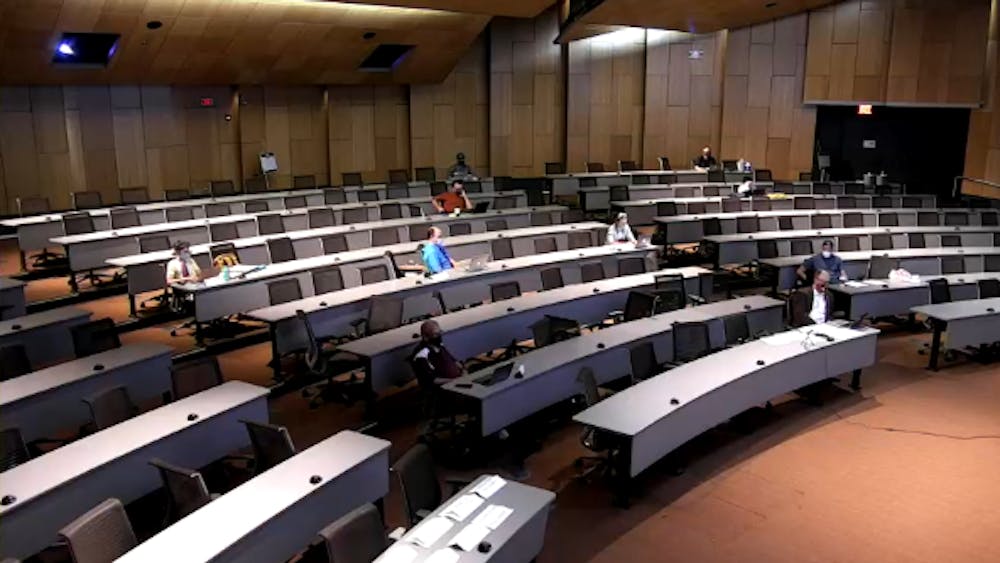ANALYSIS: What is shared governance? How is it used at CMU?
Like many other public universities, Central Michigan University follows a shared governance model. However, members of the campus community are questioning how effectively the process is being used at the university.
As defined by the American Association of University Professors (AAUP), "shared governance refers to the joint responsibility of faculty, administrations, and governing boards to govern colleges and universities. Differences in the weight of each group's voice on a particular issue should be determined by the extent of its responsibility for and expertise on that issue."
The AAUP defines those roles in shared governance:
• The faculty's primary responsibility is for "fundamental areas" such as curriculum, instruction methods, research and the educational process aspects of student life.
In 2013, the original Shared Governance and Communications Committee defined seven key "hallmarks" for effective shared governance and communication at the university.
1. At CMU, shared governance requires all constituencies to seek an optimal balance between rights and responsibilities, authority and accountability, prerogatives, and proper action to achieve the mission and vision of the University.
2. At CMU, clear and timely announcements regarding major impending decisions affecting the university widely are expected from those who might be the final authority on an issue.
3. At CMU, staff, faculty, administrators or Board members who are the final authority on key matters will, in a timely manner, seek and acknowledge input from all those affected by an impending decision; the final authority will communicate in advance how information is to be collected (e.g., how a committee is to operate) and how and by whom a decision is to be made.
4. It is incumbent on all those potentially affected by a decision to communicate precisely and fully their points of view at the appropriate time and to specify reasons for their positions on an issue to be decided.
5. Faculty members' unique roles in accomplishing the mission and vision of the university are recognized in our documents, which assign a primary role in decision-making to the faculty members in the vast majority of curricular, faculty hiring and promotion, departmental operations, and many other academic matters. However, the documents also recognize that the final decision-making and responsibility for some of these actions lies with the deans and the provost.
6. Whenever key decisions are made by a final authority, at any level, the decision and reasons for it will be communicated as fully and adequately as possible with all affected by the decision. Sensitive personnel matters and decisions made in collective bargaining negotiations are excluded from this provision.
7. At CMU, the performance of leaders at all levels will be periodically reviewed and will include feedback from the members of their constituencies, with respect to their stated goals among other measures, in a manner consistent with best practices already in existence or modeled on others from our peer institutions.
• The administration, led by the university president, is to make sure the institution ensures it follows the policies set forth by the governing board, provide leadership, facilitate effective communication and to represent the university.
• The governing board makes sure the institution upholds its mission, ensures financial resources for the university, makes final decisions and "to entrust the conduct of administration to the administrative officers."
Shared governance at CMU is "understood to be a dynamic collection of best practices for engaging, voicing, listening and discussing the interests of all groups (faculty, staff, students, administrators and trustees) when planning, making and implementing decisions for the university."
The Academic Senate has a Shared Governance and Communications Committee that was created during the 2012-13 academic year and tasked with the responsibility of "defining a path forward with effective shared governance and communications."
During the Oct. 5, 2021 Academic Senate meeting, President Bob Davies announced the creation of the "Shared Governance Task Force" to evaluate and improve the university’s system of shared governance.
“I understand I may not yet fully grasp the nuances of this community’s preferred execution of shared governance,” Davies said.
The task force currently consists of representatives from the Academic Administration, University Administration, Council of Deans, Council of Chairs, President's Cabinet, Union of Teaching Faculty, Faculty Association, Student Government Association and Academic Senate.
Andrew Criswell, Shared Governance Task Force Academic Senate representative, said the group will also add a representative for office professionals.
"Shared governance implies that when a decision is made, all the parties who are involved, who are tagged as decision makers for that particular decision, whether it's academic or administrative, are consulted and that their opinions are considered," Criswell said. "Even though the ultimate decision is usually made by one person, generally, the president, but all the other parties are supposed to be involved in the decision making process."
The task force is important, Criswell said, because during his two terms on Academic Senate he has seen several failures where shared governance was completely pushed aside or ignored.
Specifically, Criswell mentioned the lack of shared governance in the decision to make courses HyFlex for the Fall 2020 semester. Davies ensured the Academic Senate they would be consulted.
"The Board of Trustees decided that (the university) would make all classes HyFlex in the fall and that we would open," Criswell said. "This was handed to the departments as a mandate with no consultation of the Academic Senate whatsoever."
The task force also is planning an open forum, Criswell said, to discuss shared governance at CMU.







